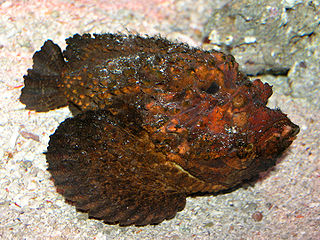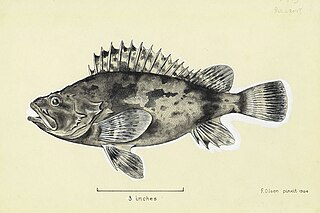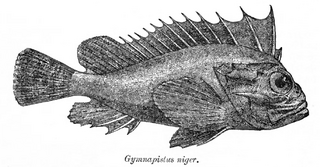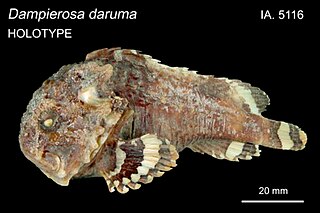
The South Australian cobbler, better known as the soldier but also known as the cobbler, devilfish or soldierfish, is a species of marine ray-finned fish, a waspfish, belonging to the subfamily Tetraroginae which is classified within the family Scorpaenidae, the scorpionfishes and their relatives. It is endemic to southern Australia. It is the only species in the monotypic genus Gymnapistes.

Synanceia verrucosa, the reef stonefish or simply stonefish, is a species of venomous, marine ray-finned fish, belonging to the subfamily Synanceiinae which is classified as being within the family Scorpaenidae, the scorpionfishes and their relatives. It is the most widespread species of stonefish, mostly found in shallow waters of the Red Sea and the Indo-Pacific. It possesses highly effective venom which can be lethal to humans. It is the type species of Synanceia.

Synanceiinae is a subfamily of venomous ray-finned fishes, waspfishes, which is classified as part of the family Scorpaenidae, the scorpionfishes and their relatives. These fishes are found in the Indo-Pacific oceans. They are primarily marine, though some species are known to live in fresh or brackish waters. The various species of this family are known informally as stonefish, stinger, stingfish and ghouls. Its species are known to have the most potent neurotoxins of all the fish venoms, secreted from glands at the base of their needle-like dorsal fin spines. The vernacular name, stonefish, for some of these fishes derives from their behaviour of camouflaging as rocks. The type species of the family is the reef stonefish.

Synanceia is a genus of ray-finned fish belonging to the subfamily Synanceiinae, the stonefish, which is classified within the family Scorpaenidae, the scorpionfish and relatives. Stonefish are the most venomous fish known; stings can be fatal to humans. They are found in the coastal regions of the Indo-Pacific. They are sometimes confused with the freshwater lionfish.

Synanceia horrida, the estuarine stonefish, hollow-cheek stonefish, horrid stonefish, rough stonefish or true stonefish, is a species of venomous, marine ray-finned fish, a stonefish belonging to the subfamily Synanceiinae which is classified as being within the family Scorpaenidae, the scorpionfishes and their relatives. It is a benthic fish which is found in the Indo-Pacific region. This species is considered to be one of the most dangerous venomous fish in the world. It is a popular exhibit in public aquaria and is found in the private aquarium trade.

The bullrout, also commonly called freshwater stonefish or kroki, is a pale yellowish to dark-brown coloured fish that lives in tidal estuaries and slow-flowing streams in eastern Australia, from Southern New South Wales to northern Queensland, Australia. It has on a very infrequent occurrence been caught at sea. Its spines are venomous. It is the only member of the genus Notesthes. It is often confused with the true stonefish.

The pitted stonefish, also known as the Pacific monkey-fish, is a species of venomous ray-finned fish, a stonefish be longing to the subfamily Synanceiinae of the family Scorpaenidae, the scorpionfishes and their relatives. It is the only species in the monotypic genus Erosa and is found in the eastern Indian Ocean and the western Pacific Ocean.
Leptosynanceia is a monotypic genus of ray-finned fish belonging to the subfamily Synanceiinae, the stonefishes, which is classified within the family Scorpaenidae, the scorpionfishes and relatives, its only species is Leptosynanceia asteroblepa which is called the mangrove stonefish in Malaysia. This species native to the brackish and fresh waters of Southeast Asia. This species grows to a total length of 23 centimetres (9.1 in). This species is an extremely dangerous fish whose venom can cause a human to die within 1 to 2 hours after contact. The pain caused by the venom is described as "agonizing".

Minous, is a genus of marine ray-finned fishes, it is the only genus in the tribe Minoini, one of the three tribes which are classified within the subfamily Synanceiinae within the family Scorpaenidae, the scorpionfishes and their relatives. They are commonly known as stingfishes. They are found in the Indo-West Pacific.

The stargazing stonefish is a species of stonefish native to the Indian Ocean and the western Pacific Ocean where it is found on muddy bottoms in estuaries. This venomous species is also a minor component of local commercial fisheries. This species grows to a length of 8 centimetres (3.1 in) SL. This species is the only known member of the genus Trachicephalus.

The marbled spinefish, also known as the yellow waspfish, is a species of ray-finned fish, a waspfish belonging to the subfamily Tetraroginae of the family Scorpaenidae, the scorpionfishes and their relatives. It is the only species in the monotypic genus Cottapistus. This species is found in the Indo-West Pacific.
Liocranium is a small genus of marine ray-finned fishes, waspfishes belonging to the subfamily Tetraroginae, which is classified as part of the family Scorpaenidae, the scorpionfishes and their relatives. The fishes in this genus are found in the eastern Indian Ocean and the western Pacific Ocean.
Neocentropogon is a poorly known genus of marine ray-finned fishes, waspfishes belonging to the subfamily Tetraroginae, which is classified as part of the family Scorpaenidae, the scorpionfishes and their relatives. The fishes in this genus are native to the Indian Ocean and the western Pacific Ocean.

Paracentropogon is a genus of ray-finned fishes, waspfishes belonging to the subfamily Tetraroginae, which is classified as part of the family Scorpaenidae, the scorpionfishes and their relatives, These fish are found in the Indian Ocean and western Pacific Ocean.

Pseudovespicula is a genus of venomous ray-finned fishes, waspfishes belonging to the subfamily Tetraroginae, which is classified as part of the family Scorpaenidae, the scorpionfishes and their relatives. It has been considered to be a monotypic genus, containing only the type species, Pseudovespicula dracaena, but some authorities classify three species within the genus. The genus is found in the Indo-Pacific region.

Richardsonichthys, is a monotypic genus of marine ray-finned fish belonging to the subfamily Tetraroginae, the waspfishes, which is classified as part of the family Scorpaenidae, the scorpionfishes and their relatives. The only species in the genus is the whiteface waspfish, also known as the whitebelly roguefish, rouge fish, Torres Strait soldier fish or Richardson's waspfish. This species is native to reefs of the Indian Ocean and the western Pacific Ocean.

Snyderina is a genus of ray-finned fishes, waspfishes belonging to the subfamily Tetraroginae, which is classified as part of the family Scorpaenidae, the scorpionfishes and their relatives. These fishes are found in the western Indian Ocean and the western Pacific Ocean.

Tetraroge is a genus of ray-finned fishes, waspfishes belonging to the subfamily Tetraroginae, which is classified as part of the family Scorpaenidae, the scorpionfishes and their relatives. These fishes are native to the Indian Ocean and the western Pacific Ocean.

Choridactylini, commonly known as stingfishes, stingers or ghouls, is a tribe of venomous ray-finned fishes classified within the subfamily Synanceiinae, the stonefishes, part of the family Scorpaenidae, the scorpionfishes and their relatives. These fishes are found in the Indo-Pacific.

The daruma stinger, also known as the North-western stonefish, is a species of venomous ray-finned fish, a stonefish belonging to the subfamily Synanceiinae of the family Scorpaenidae, the scorpionfishes and their relatives. It is the only species in the monotypic genus Dampierosa and is endemic to Australia.



















